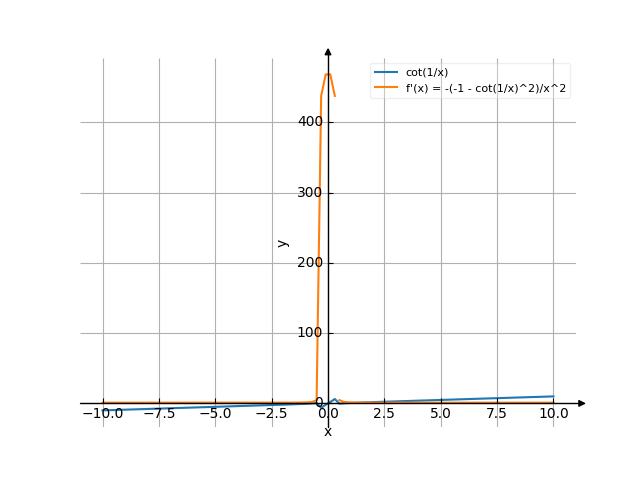Derivative of cot(1/x)
The solution
/ 1\ cot|1*-| \ x/
d / / 1\\ --|cot|1*-|| dx\ \ x//
-
There are multiple ways to do this derivative.
Method #1
-
Rewrite the function to be differentiated:
-
Let .
-
Apply the power rule: goes to
-
Then, apply the chain rule. Multiply by :
-
Rewrite the function to be differentiated:
-
Apply the quotient rule, which is:
and .
To find :
-
Let .
-
The derivative of sine is cosine:
-
-
Then, apply the chain rule. Multiply by :
-
Apply the quotient rule, which is:
and .
To find :
-
The derivative of the constant is zero.
To find :
-
Apply the power rule: goes to
Now plug in to the quotient rule:
-
The result of the chain rule is:
-
To find :
-
Let .
-
The derivative of cosine is negative sine:
-
-
Then, apply the chain rule. Multiply by :
-
Apply the quotient rule, which is:
and .
To find :
-
The derivative of the constant is zero.
To find :
-
Apply the power rule: goes to
Now plug in to the quotient rule:
-
The result of the chain rule is:
-
Now plug in to the quotient rule:
The result of the chain rule is:
Method #2
-
Rewrite the function to be differentiated:
-
Apply the quotient rule, which is:
and .
To find :
-
Let .
-
The derivative of cosine is negative sine:
-
-
Then, apply the chain rule. Multiply by :
-
Apply the quotient rule, which is:
and .
To find :
-
The derivative of the constant is zero.
To find :
-
Apply the power rule: goes to
Now plug in to the quotient rule:
-
The result of the chain rule is:
-
To find :
-
Let .
-
The derivative of sine is cosine:
-
Then, apply the chain rule. Multiply by :
-
Apply the quotient rule, which is:
and .
To find :
-
The derivative of the constant is zero.
To find :
-
Apply the power rule: goes to
Now plug in to the quotient rule:
-
The result of the chain rule is:
-
Now plug in to the quotient rule:
-
-
Now simplify:
The answer is:
/ 2/ 1\\
-|-1 - cot |1*-||
\ \ x//
------------------
2
x
/ /1\\
| cot|-||
/ 2/1\\ | \x/|
2*|1 + cot |-||*|-1 + ------|
\ \x// \ x /
-----------------------------
3
x
/ 2/1\ /1\ 2/1\\
| 1 + cot |-| 6*cot|-| 2*cot |-||
/ 2/1\\ | \x/ \x/ \x/|
2*|1 + cot |-||*|3 + ----------- - -------- + ---------|
\ \x// | 2 x 2 |
\ x x /
--------------------------------------------------------
4
x


![Find the derivative of y' = f'(x) = cot(1/x) (cotangent of (1 divide by x)) - functions. Find the derivative of the function at the point. [THERE'S THE ANSWER!] cot(1/x)](/media/krcore-image-pods/176/hash/derivative/9/10/1a555e6f27c5470ab3a9ac2a97573.png)
 Derivative of e^x*x
Derivative of e^x*x
 Derivative of e^(x-1)
Derivative of e^(x-1)
 Derivative of cot(1/x)
Derivative of cot(1/x)
 cot(1/x)
cot(1/x)